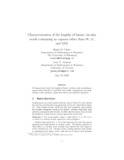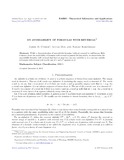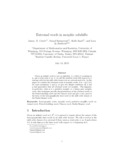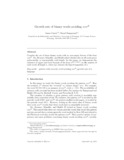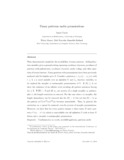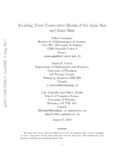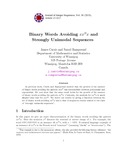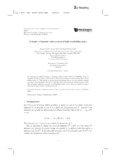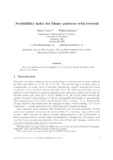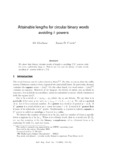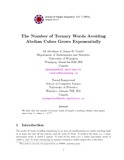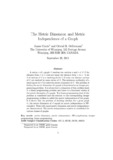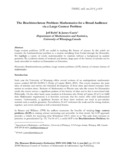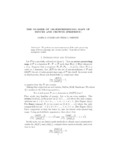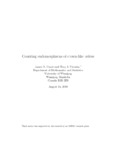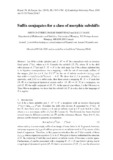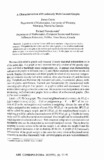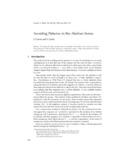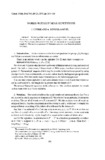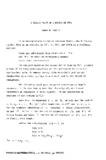James D. Currie
Browse by
Recent Submissions
-
Characterization of the lengths of binary circular words containing no squares other than 00, 11, and 0101
(2020-05-19)We characterize exactly the lengths of binary circular words containing no squares other than 00, 11, and 0101. -
On avoidability of formulas with reversal
(EDP Sciences, 2018-02-13)While a characterization of unavoidable formulas (without reversal) is well-known, little is known about the avoidability of formulas with reversal in general. In this article, we characterize the unavoidable formulas ... -
Extremal words in morphic subshifts
(Elsevier, 2014-01-22)Given an infinite word x over an alphabet A, a letter b occurring in x, and a total order \sigma on A, we call the smallest word with respect to \sigma starting with b in the shift orbit closure of x an extremal word of ... -
Growth rate of binary words avoiding xxxR
(Elsevier, 2016-01)Abstract Consider the set of those binary words with no non-empty factors of the form xxx^R. Du, Mousavi, Schaeffer, and Shallit asked whether this set of words grows polynomially or exponentially with length. In this ... -
Unary patterns under permutations
(Elsevier, 2018-06-04)Thue characterized completely the avoidability of unary patterns. Adding function variables gives a general setting capturing avoidance of powers, avoidance of patterns with palindromes, avoidance of powers under coding, ... -
Avoiding three consecutive blocks of the same size and same sum
(Association of Computing Machinery, 2014-04)We show that there exists an infinite word over the alphabet {0,1,3,4} containing no three consecutive blocks of the same size and the same sum. This answers an open problem of Pirillo and Varricchio from1994. -
Binary Words Avoiding xxRx and Strongly Unimodal Sequences
(2015-09-14)In previous work, Currie and Rampersad showed that the growth of the number of binary words avoiding the pattern xxxR was intermediate between polynomial and exponential. We now show that the same result holds for the ... -
A family of formulas with reversal of high avoidability index
(World Scientific, 2017)We present an infinite family of formulas with reversal whose avoidability index is bounded between 4 and 5, and we show that several members of the family have avoidability index 5. This family is particularly interesting ... -
Avoidability index for binary patterns with reversal
(2017)For every pattern p over the alphabet {x,x^R,y,y^R}, we specify the least k such that p is k-avoidable. -
Attainable lengths for circular binary words avoiding k-powers
(The Belgian Mathematical Society, 2005)We show that binary circular words of length n avoiding 7/3+ powers exist for every sufficiently large n. This is not the case for binary circular words avoiding k+ powers with k < 7/3 -
The Number of Ternary Words Avoiding Abelian Cubes Grows Exponentially
(2004-06-19)We show that the number of ternary words of length n avoiding abelian cubes grows faster than r^n, where r = 2^{1/24} -
The metric dimension and metric independence of a graph
(The Charles Babbage Research Centre, 2001)A vertex x of a graph G resolves two vertices u and v of G if the distance from x to u does not equal the distance from x to v. A set S of vertices of G is a resolving set for G if every two distinct vertices of G are ... -
The Brachistochrone Problem: Mathematics for a Broad Audience via a Large Context Problem
(Montana Council of Teachers of Mathematics & Information Age Publishing, 2008)Large context problems (LCP) are useful in teaching the history of science. In this article we consider the brachistochrone problem in a context stretching from Euclid through the Bernoullis. We highlight a variety of ... -
The number of order–preserving maps of fences and crowns
(Springer, 1991-06)We perform an exact enumeration of the order-preserving maps of fences (zig-zags) and crowns (cycles). From this we derive asymptotic results. -
Counting endomorphisms of crown-like orders
(Springer, 2002-12)The authors introduce the notion of crown-like orders and introduce powerful tools for counting the endomorphisms of orders of this type. -
Suffix conjugates for a class of morphic subshifts
(Cambridge University Press, 2015-09)Let A be a finite alphabet and f: A^* --> A^* be a morphism with an iterative fixed point f^\omega(\alpha), where \alpha{} is in A. Consider the subshift (X, T), where X is the shift orbit closure of f^\omega(\alpha) and ... -
A Characterization of Fractionally Well-Covered Graphs
(Ars Combinatoria, 1991)A graph is called well-covered if every maximal independent set has the same size. One generalization of independent sets in graphs is that of a fractional cover -- attach nonnegative weights to the vertices and require ... -
Avoiding Patterns in the Abelian Sense
(Canadian Mathematical Society, 2001-08)We classify all 3 letter patterns that are avoidable in the abelian sense. A short list of four letter patterns for which abelian avoidance is undecided is given. Using a generalization of Zimin words we deduce some ... -
Words without Near-Repetitions
(Canadian Mathematical Society, 1992-06-01)We find an infinite word w on four symbols with the following property: Two occurrences of any block in w must be separated by more than the length of the block. That is, in any subword of w of the form xyx, the length of ... -
A direct proof of a result of Thue
(Utilitas Mathematica, 1984)

